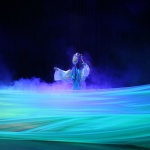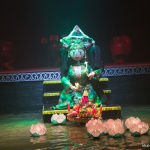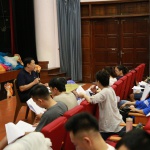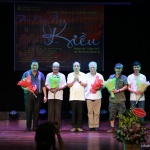There are many puppet art forms in the world: Stick, string, shadow, effigy, mask and human puppets. But water puppetry is unique in Vietnam. This puppet art form reflects the daily life of wet rice farmers such as ploughing, rice transplanting, weaving and water scooping etc.
Water puppetry came into existence possibly in the early Ly Dynasty (1010 - 1225) and maybe earlier and its vestiges can be seen in many places. The first evidence in writing on Vietnam’s water puppetry is the inscription on the Sùng Thiện Diện Linh Stele, built in 1121 in Long Đọi Sơn Pagoda, Ha Nam province which wrote in part: "Releasing golden tortoises carrying three mounts on their heads, fluttering over intermittent river waves. Displaying their golden shells, and showing their four legs. Swimming in sluggish flow and casting a long glance at the river banks. Ejecting water from their mouths to shore, looking at very steep cliff, bending down on water to explore the blue sky amidst sweet melody. When grotto is open, angles appear. They all come from Celestial Palace to this world. Waving small hands to offer whirlwinds and wrinkling eyebrows to praise the good fate of the country. Flocks of precious birds dancing and singing and gentle animals look elegant in herds ..."
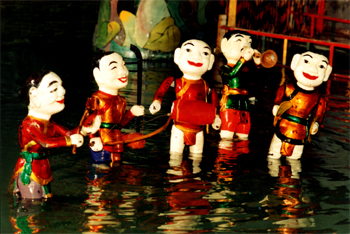
Meanwhile Rạch villagers in Hồng Quang commune, Nam Trực district, Nam Dinh province have said that their craft of making puppets for traditional water puppet art form came into existence since the 10th century. This means, water puppet art reached a high level in the Ly Dynasty and has been handed down from one generation to another to date.
The stage for water puppet shows, also called water pavilion, is often set up in front of a communal house or a village pagoda. Two major old water pavilions still seen now are one in Thầy Pagoda, Ha Tay and one in Gióng Temple in Sóc Sơn, Hanoi.
Puppets which are called by artisans “con trò” are made of old fig wood, very light and soft. The puppets, after being made are soaked in water for sometime until they can no longer absorb water, then they are coasted with a layer of natural paint, also called “sơn thếp” (red-lacquered paint), which are water resistant.
Compared to other forms of puppet arts in the world, Vietnamese puppetry takes water as its key element, making stage for its performance and hiding the performing techniques. The audiences cannot see what is going on under water. What is skillful of the artists who created this art form is that they can calculate the floating level and propulsive force of water so as to make the puppets live in the water surface more lively. And this is one of the secrets handed down by each water puppet troupe. Ancient people did not hand down their traditional craft to their daughters fearing that when getting married, they will disclose the secret to other guilds. So each guild has its own puppets and plays.
Each puppet is a traditional sculptural work. The face of the puppet and its dresses bear typical features of Vietnam, reflecting different topics such as the fight for national construction and defense of our ancestors through different stages of history such as the victory won by the Trung Sisters or the Bạch Đằng historical battle or the daily life of the people. The most typical character is Teu, with rounded body and mischievous and optimistic smile. Raising the curtain for the show, Teu appears in a very joyful and mischievous manner, as a narrator. Then the show begins with different items.
In recent years, water puppet art form has been studied by scientists and restored to be raised to international plane. Many Vietnamese water puppet troupes have been invited to attend international puppet festivals and won many high prizes and awards, drawing great attention from audiences in many countries. It is hoped that based on this very encouraging initial foundation, we will fully restore water puppetry which has long been lost.
Nguồn: simplevietnam.com
